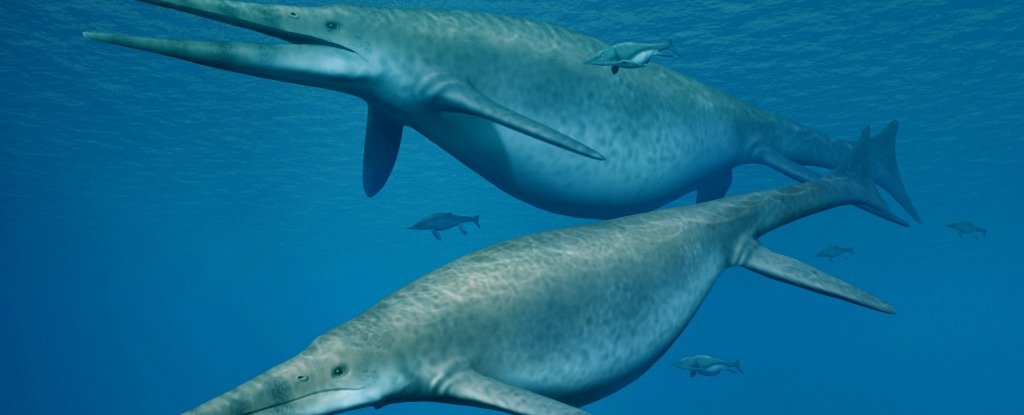Mysterious fragments of fossilized bone proposed to be from a creature approaching the size of a blue whale could technically have been left by any one of a number of long-extinct giants.
Scientists in Germany have now figured out a potential way to identify just what kind of giant left them, concluding they were once inside true leviathans of the sea – air-breathing, marine reptiles known as ichthyosaurs.
Ichthyosaurs thrived in the oceans more than a hundred million years ago. These fearsome predators looked sort of like sinister dolphins, ranging in size from a meter or two (a few feet) to as long as a bus, at around 20 meters. First discovered in Bristol in 1850, their bones have puzzled scientists pretty much ever since.
Most giant ichthyosaurs are represented by “woefully incomplete, disarticulated, and fragmentary material,” experts say. Unless by some super-rare fluke, the fossilized skeleton of an ichthyosaur shows up exceptionally well-preserved, it’s often hard for paleontologists to tell where the fragmented fossils came from.
Even today, not all experts accept that various bones, found across Europe, belong to ichthyosaurs. Some suggest they derive from extinct crocodile-like predators, or even land-living dinosaurs, known or unknown.
Peering through a special microscope, paleontologists Marcello Perillo and Martin Sander, from the University of Bonn in Germany, have figured out a way to tell the difference. The microstructure of tissue in the fossilized jawbone, they say, is a dead giveaway.
“Bones of similar species generally have a similar structure,” explains Perillo, who is conducting the research for his master’s thesis.
“Osteohistology – the analysis of bone tissue – can thus be used to draw conclusions about the animal group from which the find originates.”
To test that idea, Perillo put several presumed ichthyosaurus jawbones that had not yet been officially classified under the microscope. They came from France, Germany, and southwest England.
Along with confirmed ichthyosaur bones, these ‘mystery’ jaws all showed long strands of fibrous collagen that were woven in a unique, shared pattern. This suggests they come from the same animal group.
Even ichthyosaur fossils found in Canada held a similar pattern to those found in Europe.
“This structure is not found in fossil samples from other animal groups that I have studied,” says Perillo.
“Therefore, it seems highly probable that the fragments in question also belong to an ichthyosaur and that the findings refute the claim that the bones come from a land-living dinosaur.”
Other scientists have suspected this might be the case, but their arguments were mostly based on morphology, comparing known ichthyosaur bones to suspected ones.
For instance, mysterious fossilized jaw bones that were found in southwest England in the Victorian era, were originally attributed to land dinosaurs, but now, some scientists think they are a better match to ichthyosaurs.
Perillo and Sander have now analyzed those very same jaw bones with more than just their eyes and come to the same conclusion.
The microscopic tissue pattern in the bones does not match sauropods, stegosauruses, or other suspected land-living dinosaurs, the researchers conclude.
The unique structure, they add, holds similarities to carbon fiber-reinforced materials, which would give great stability during rapid growth. Given one of the largest of the bone fragments has been suggested to have come from a whale-sized beast, the hunter’s jaws would have needed to withstand some extraordinary stresses.
“These huge jaws would have been exposed to strong shearing forces even when the animal was eating normally,” explains Perillo. “It is possible that these animals also used their snouts to ram into their prey, similar to the orcas of today. However, this is still pure speculation at this time.”
The study was published in PeerJ.

Dr. Thomas Hughes is a UK-based scientist and science communicator who makes complex topics accessible to readers. His articles explore breakthroughs in various scientific disciplines, from space exploration to cutting-edge research.








